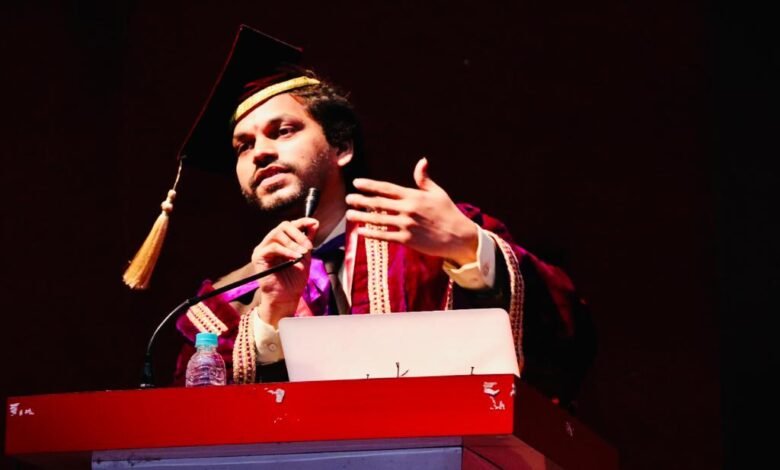
An Interview with Prof. Dr. Pratik Mungekar on Online Content vs. Real Knowledge
Q1: As an esteemed scientist, professor, and Vice Chancellor of Wisdom Univesity, Nigeria, Royal University, Singapore, Unified Theological Seminary, USA & Webiston University Zimbabwe what are your observations regarding the impact of online content on the pursuit of real knowledge?
The impact of online content on the pursuit of real knowledge has been both positive and negative. On the positive side, online content has made it easier than ever before to access a vast array of information on almost any topic imaginable. Online courses and educational resources have made learning more accessible and affordable, allowing individuals from all walks of life to pursue their educational goals.
However, the abundance of information online can also be overwhelming, and not all of it is accurate or reliable. Misinformation and fake news can spread quickly, leading to misunderstandings and confusion. Additionally, online content can sometimes be shallow or incomplete, offering only a superficial understanding of a topic without providing the depth and nuance that comes from extensive study and research.
Therefore, it is important to approach online content with a critical eye and to seek out reliable sources of information. While online resources can be a valuable tool in the pursuit of real knowledge, they should be used in conjunction with traditional methods of education and research to ensure a well-rounded and comprehensive understanding of a topic.
Q2: With the vast availability of online content, how can individuals discern between reliable sources and misleading or inaccurate information?
With the abundance of online content available, it can be challenging to discern between reliable sources and misleading or inaccurate information. However, there are several strategies individuals can use to evaluate the credibility of online content:
1.Check the source: Verify the source of the information and the author’s credentials. Look for information from reputable sources such as government agencies, academic institutions, and established news organizations.
2.Check for bias: Be aware of the potential for bias in the information presented. Check for balanced reporting and avoid sources that are excessively partisan or present a biased perspective.
3.Verify the information: Check the accuracy of the information presented by cross-referencing it with other reliable sources and fact-checking websites.
4.Look for evidence: Evaluate the evidence presented to support the information. Look for studies or data that back up the claims made.
5.Consider the tone: Be wary of content that uses an emotional tone or sensationalist language. This can be a red flag for misleading or inaccurate information.
6.Use your judgment: Ultimately, use your judgment to determine the credibility of the content. If something seems too good to be true or doesn’t ring true, it may be worth investigating further.
By using these strategies, individuals can help ensure that the information they consume online is accurate and reliable. It’s important to remember that critical thinking and skepticism are key when evaluating online content.
Q3: What potential risks or challenges do individuals face when relying solely on online content for knowledge acquisition?
While online content can be a valuable tool for knowledge acquisition, there are several potential risks and challenges that individuals may face when relying solely on this medium:
1.Limited perspective: Online content can provide a narrow perspective on a topic, and it may not be as comprehensive as traditional forms of education, such as attending lectures or participating in discussions.
2.Inaccurate information: Online content can contain inaccuracies and misinformation, which can lead to misunderstandings and confusion.
3.Limited interaction: Online learning can be isolating, with limited opportunities for interaction with peers and instructors. This can limit the depth of learning and the opportunity to explore and discuss ideas with others.
4.Distractions and time management: With so many distractions online, it can be challenging to stay focused and manage time effectively when learning online.
5.Lack of structure and accountability: Online learning lacks the structure and accountability of traditional forms of education. This can make it challenging to stay motivated and on track with learning goals.
6.Limited access: Not everyone has access to the internet or the necessary technology to access online content, which can limit the opportunity to learn.
7.Dependence on technology: Relying solely on online content can create a dependence on technology and limit other important life skills such as social interaction and physical activities.
It is important for individuals to consider these potential risks and challenges when relying solely on online content for knowledge acquisition and to supplement online learning with other forms of education and interaction to ensure a well-rounded learning experience.
Q4: How can educational institutions adapt to the evolving landscape of online content to ensure the promotion of real knowledge among students?
Educational institutions can adapt to the evolving landscape of online content by taking the following steps to ensure the promotion of real knowledge among students:
1.Incorporate online resources into the curriculum: Educational institutions can integrate online resources into the curriculum, making use of the vast array of educational material available online. This can include online courses, open educational resources, and educational videos.
2.Promote critical thinking: Educational institutions can teach critical thinking skills to help students evaluate the credibility of online content and distinguish between reliable and unreliable sources of information.
3.Foster collaboration and interaction: Educational institutions can create opportunities for collaboration and interaction between students and instructors, both online and offline. This can include discussion forums, group projects, and live online sessions.
4.Provide guidance and support: Educational institutions can provide guidance and support to students to help them navigate the vast array of online content and make informed decisions about the information they consume.
5.Emphasize the importance of traditional forms of education: Educational institutions can emphasize the importance of traditional forms of education such as attending lectures, participating in discussions, and conducting research in addition to online content.
6.Stay up-to-date with technology: Educational institutions can stay up-to-date with technological advancements and incorporate new technologies into the curriculum to ensure that students are prepared for the modern workplace.
By taking these steps, educational institutions can adapt to the evolving landscape of online content and ensure the promotion of real knowledge among students.
Q5: In your opinion, how can individuals strike a balance between utilizing online content for learning and pursuing deeper knowledge through traditional offline resources?
In my opinion, individuals can strike a balance between utilizing online content for learning and pursuing deeper knowledge through traditional offline resources by following these strategies:
1.Set clear learning goals: Individuals should identify their learning goals and determine which resources will best help them achieve those goals. This can help individuals prioritize their learning and balance online and offline resources accordingly.
2.Use online resources for basic understanding: Online content can be a great starting point for understanding basic concepts and gaining a general overview of a topic. However, individuals should be aware that online resources may not provide a comprehensive understanding of a topic.
3.Supplement online learning with offline resources: Individuals can supplement their online learning with offline resources such as books, academic journals, and attending lectures or workshops. This can help individuals gain a deeper understanding of a topic and engage with it in a more meaningful way.
4.Seek out mentorship and guidance: Individuals can seek out mentorship and guidance from experts in their field to help them gain a deeper understanding of a topic and develop critical thinking skills.
5.Stay engaged with the learning process: Individuals should actively engage with the learning process by asking questions, participating in discussions, and seeking feedback from peers and instructors. This can help individuals stay motivated and on track with their learning goals.
By following these strategies, individuals can strike a balance between utilizing online content for learning and pursuing deeper knowledge through traditional offline resources, allowing them to gain a well-rounded understanding of a topic.
Q6: What role does critical thinking play in navigating online content and distinguishing genuine knowledge from misinformation or biased perspectives?
Critical thinking plays a crucial role in navigating online content and distinguishing genuine knowledge from misinformation or biased perspectives. When evaluating online content, critical thinking allows individuals to consider the credibility, accuracy, and relevance of the information presented.
Here are some ways critical thinking can help individuals navigate online content:
1.Evaluate the credibility of the source: Critical thinking involves evaluating the credibility of the source of information, such as the author, publisher, or website. Is the author an expert in the field? Is the publisher reputable? Is the website biased or credible?
2.Assess the accuracy of the information: Critical thinking involves assessing the accuracy of the information presented. Are the claims supported by evidence? Is the information consistent with other credible sources?
3.Consider the relevance of the information: Critical thinking involves considering the relevance of the information presented. Is the information applicable to the individual’s needs and interests?
4.Recognize bias: Critical thinking involves recognizing bias in online content. Is the information presented in an objective manner? Are there any underlying biases or agendas?
By employing critical thinking skills, individuals can navigate online content more effectively and make informed decisions about the information they consume. This can help individuals distinguish genuine knowledge from misinformation or biased perspectives, ultimately promoting a deeper understanding of a topic.
Q7: Are there any specific strategies or tools that you recommend for individuals to verify the credibility and accuracy of online content?
Yes, there are several strategies and tools that individuals can use to verify the credibility and accuracy of online content. Here are a few:
1.Check the source: Look for information about the author, publisher, and website. Are they reputable and trustworthy? Look for clues such as a professional design, clear and concise language, and a balanced tone.
2.Verify the information: Check the information presented against other credible sources. Look for evidence to support the claims made in the content. Use fact-checking websites such as Snopes or FactCheck.org to verify the accuracy of information.
3.Use search engines effectively: Use search engines to find additional information about the topic and to verify the credibility of the information presented. Use advanced search features such as date range and domain-specific searches to find the most relevant and credible information.
4.Check for bias: Look for any signs of bias or agenda in the content. Evaluate the language used and the tone of the content. Check for any affiliations or conflicts of interest that may influence the content.
5.Use tools and plugins: There are several tools and plugins available that can help verify the credibility and accuracy of online content. For example, the Web of Trust (WOT) browser plugin rates websites based on user reviews and ratings, providing an indication of the website’s reliability. Another plugin, the Fake News Detector, can identify potentially false news articles and provide a credibility score based on the source and content.
By using these strategies and tools, individuals can verify the credibility and accuracy of online content, promoting a deeper understanding of a topic and helping to distinguish genuine knowledge from misinformation or biased perspectives.
Q8: How can educators and researchers collaborate to bridge the gap between online content and real knowledge, fostering a more comprehensive learning experience for students?
Educators and researchers can collaborate to bridge the gap between online content and real knowledge by taking the following steps:
1.Promote critical thinking: Educators can promote critical thinking skills among students, encouraging them to evaluate online content and distinguish reliable sources from unreliable ones. Researchers can provide guidance on how to assess the credibility and accuracy of online content, helping educators to design effective lesson plans.
2.Incorporate offline resources: Educators can incorporate offline resources such as books, academic journals, and primary sources to supplement online content. Researchers can help identify relevant offline resources that support the learning objectives.
3.Collaborate on curriculum development: Educators and researchers can collaborate on curriculum development, identifying topics that are best suited for online learning and those that require more in-depth offline resources. Researchers can provide input on which topics are best suited for online learning and which require a more hands-on approach.
4.Use online resources for active learning: Educators can use online resources for active learning activities such as online discussions, simulations, and virtual labs. Researchers can provide guidance on the most effective ways to use online resources for active learning.
5.Evaluate the effectiveness of online learning: Educators and researchers can collaborate to evaluate the effectiveness of online learning, using data to improve the quality of online content and instructional design. Researchers can help educators to design studies that evaluate the effectiveness of online learning.
By collaborating, educators and researchers can bridge the gap between online content and real knowledge, fostering a more comprehensive learning experience for students. This can help students to gain a deeper understanding of a topic, develop critical thinking skills, and prepare for success in a rapidly changing world.
Q9: In the digital era, how can individuals develop information literacy skills to effectively evaluate and analyze online content for its authenticity and reliability?
In the digital era, developing information literacy skills is crucial for individuals to effectively evaluate and analyze online content for its authenticity and reliability. Here are some ways to develop information literacy skills:
1.Understand the nature of online content: Individuals should understand the different types of online content, including articles, blogs, videos, and social media posts. They should be aware of the potential biases and agendas that may influence the content.
2.Evaluate the credibility of sources: Individuals should learn how to evaluate the credibility of online sources, including the author, publisher, and website. They should look for clues such as professional design, clear language, and balanced tone.
3.Check for accuracy: Individuals should verify the accuracy of online content by checking the information presented against other credible sources. They should use fact-checking websites such as Snopes or FactCheck.org to verify the accuracy of information.
4.Identify bias: Individuals should identify any signs of bias or agenda in the content. They should evaluate the language used and the tone of the content. They should also check for any affiliations or conflicts of interest that may influence the content.
5.Use search engines effectively: Individuals should learn how to use search engines effectively to find relevant and credible information. They should use advanced search features such as date range and domain-specific searches to find the most relevant and credible information.
6.Use critical thinking: Individuals should use critical thinking skills to evaluate and analyze online content. They should ask questions, check sources, and evaluate evidence to determine the authenticity and reliability of the information presented.
By developing information literacy skills, individuals can effectively evaluate and analyze online content for its authenticity and reliability, promoting a deeper understanding of a topic and helping to distinguish genuine knowledge from misinformation or biased perspectives.
Q10: Looking ahead, what do you envision as the future of online content and its impact on the pursuit of real knowledge?
Looking ahead, the future of online content is likely to have a significant impact on the pursuit of real knowledge. Here are some possible trends and developments:
1.Continued growth of online learning: Online learning is likely to continue to grow in popularity, offering learners access to a wide range of educational content. This may lead to a more democratized and accessible approach to education, allowing more people to gain knowledge and skills.
2.Artificial intelligence and machine learning: Artificial intelligence and machine learning are likely to play an increasingly important role in the creation and distribution of online content. This may lead to more personalized and adaptive learning experiences, tailored to the needs of individual learners.
3.Expansion of immersive technologies: Immersive technologies such as virtual and augmented reality are likely to become more widely used in online learning, offering learners more engaging and interactive experiences.
4.Greater focus on digital literacy and information literacy: With the vast amount of online content available, there will be a growing need for individuals to develop digital literacy and information literacy skills to navigate and evaluate online content effectively.
5.Continued importance of critical thinking: As the amount of online content continues to grow, critical thinking will become increasingly important in distinguishing reliable sources from unreliable ones and evaluating the credibility and accuracy of online content.
Overall, the future of online content is likely to offer both opportunities and challenges for the pursuit of real knowledge. While online learning offers greater access to knowledge and skills, it is important to continue to develop skills in critical thinking and digital literacy to navigate the vast amount of online content effectively.
In conclusion, the vast availability of online content has greatly impacted the pursuit of real knowledge. As individuals increasingly turn to online resources for learning, it is essential to develop critical thinking and information literacy skills to distinguish genuine knowledge from misinformation and biased perspectives. Educators and researchers must adapt to the evolving landscape of online content to ensure the promotion of real knowledge among students. Strategies for verifying the credibility and accuracy of online content include evaluating sources, checking for accuracy, identifying bias, using search engines effectively, and using critical thinking. Looking ahead, the future of online content is likely to bring both opportunities and challenges, including the continued growth of online learning, the expansion of immersive technologies, and the importance of digital literacy and critical thinking. Ultimately, it is vital to strike a balance between utilizing online content for learning and pursuing deeper knowledge through traditional offline resources to gain a comprehensive understanding of a topic.






